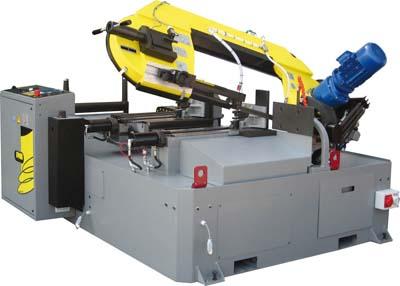
Pat Mooney Inc., The Saw Company announces a new addition to its FMB line of automatic band saws, the Pegasus CNC. The Pegasus CNC is designed for mitre sawing from 0 to 60 degrees in automatic cycle. The CNC control will allow users to set a cut length and cutting angle for each step in a cycle. For the initial cycle a workpiece, for instance, can be indexed to 32" length and cut at 0 degrees, while the second cycle has been programmed for a 64" length and cut angle at 45 degrees. The unique design of the saw head combines a special aluminum alloy with steel and cast iron for a balanced saw head that absorbs cutting vibrations. The height return of the saw band is set automatically to the workpiece. Also, the rotation of the saw head is fully programmable from the machine control panel.The rotation is powered by hydraulic cylinder and the cutting angle maintained via magnetic band. Once the saw head is at the desired cutting angle, the saw head is locked into position via hydraulic cylinder. Other features include dynamometric band tension to ensure consistent blade tension; blade rotation sensor that monitors the band wheels; saw blade drive and blade speed control that features an enclosed direct drive gear box for long-life performance; and saw blade feed system with dual controls for feed and speed. The CNC allows 99 cutting programs to be stored with each program having 100 steps (number of cuts and cut length). Desired cut length is input and if more than one index required, CNC will automatically calculate the required number of strokes and blade kerf calculation.
Contact Details
Related Glossary Terms
- bandsaw blade ( band)
bandsaw blade ( band)
Endless band, normally with serrated teeth, that serves as the cutting tool for cutoff or contour band machines.
- computer numerical control ( CNC)
computer numerical control ( CNC)
Microprocessor-based controller dedicated to a machine tool that permits the creation or modification of parts. Programmed numerical control activates the machine’s servos and spindle drives and controls the various machining operations. See DNC, direct numerical control; NC, numerical control.
- feed
feed
Rate of change of position of the tool as a whole, relative to the workpiece while cutting.
- kerf
kerf
Width of cut left after a blade or tool makes a pass.
- sawing
sawing
Machining operation in which a powered machine, usually equipped with a blade having milled or ground teeth, is used to part material (cutoff) or give it a new shape (contour bandsawing, band machining). Four basic types of sawing operations are: hacksawing (power or manual operation in which the blade moves back and forth through the work, cutting on one of the strokes); cold or circular sawing (a rotating, circular, toothed blade parts the material much as a workshop table saw or radial-arm saw cuts wood); bandsawing (a flexible, toothed blade rides on wheels under tension and is guided through the work); and abrasive sawing (abrasive points attached to a fiber or metal backing part stock, could be considered a grinding operation).
- sawing machine ( saw)
sawing machine ( saw)
Machine designed to use a serrated-tooth blade to cut metal or other material. Comes in a wide variety of styles but takes one of four basic forms: hacksaw (a simple, rugged machine that uses a reciprocating motion to part metal or other material); cold or circular saw (powers a circular blade that cuts structural materials); bandsaw (runs an endless band; the two basic types are cutoff and contour band machines, which cut intricate contours and shapes); and abrasive cutoff saw (similar in appearance to the cold saw, but uses an abrasive disc that rotates at high speeds rather than a blade with serrated teeth).
